Tài liệu Javascript bible_ Chapter 1 doc
Bạn đang xem bản rút gọn của tài liệu. Xem và tải ngay bản đầy đủ của tài liệu tại đây (43.12 KB, 7 trang )
JavaScript’s Role
in the World
Wide Web
F
or the many individuals responsible today for content on
the World Wide Web, it wasn’t long ago that terms such
as
HTML (Hypertext Markup Language) and URL (Universal
Resource Locator) seemed like words from a foreign
language. Growth in activity on the Web — producing content
and surfing it — has been nothing short of phenomenal. Some
may even call the hyperactivity “scary.” I could quote the
estimates of the number of Web sites available on the
Internet, but that count would be woefully outdated before
these words ever reached a printing press.
Developers of Web software technologies are now in a
desperate race to catch up with the enthusiasm that people
have for the Internet — and for the Web in particular. Web
site authors are constantly seeking tools that will make their
sites engaging (if not “cool”) with the least amount of effort.
This is particularly true when the task is in the hands of
people more comfortable with writing, graphic design, and
page layout than with hard-core programming. Not every
Webmaster has legions of experienced programmers on hand
to whip up some special, custom enhancement for the site.
Nor does every Web author have control over the Web server
that physically houses the collection of HTML and graphics
files. JavaScript brings programming power within reach of
anyone familiar with HTML, even when the server is a black
box at the other end of a telephone line.
Competition on the Web
Web page publishers revel in logging as many visits to
their sites as possible. Regardless of the questionable
accuracy of Web page hit counts, a site consistently logging
10,000 dubious hits per week is clearly far more popular than
one with 1,000 dubious hits per week. Even if the precise
number is unknown, relative popularity is a valuable
measure.
1
1
CHAPTER
✦ ✦ ✦ ✦
In This Chapter
How JavaScript
blends with other
Web authoring
technologies
The history of
JavaScript
What kinds of jobs
you should and
should not entrust to
JavaScript
✦ ✦ ✦ ✦
4
Part 1 ✦ Getting Started with JavaScript
Encouraging people to visit a site frequently is the Holy Grail of Web publishing.
Competition for viewers is enormous. Not only is the Web like a million-channel
television, but the Web competes for viewers’ attention with all kinds of computer-
generated information. That includes anything that appears on-screen as
interactive multimedia.
Users of entertainment programs, multimedia encyclopedias, and other colorful,
engaging, and mouse-finger-numbing actions are accustomed to high-quality
presentations. Frequently, these programs sport first-rate graphics, animation, live-
action video, and synchronized sound. In contrast, the lowest-common-
denominator Web page has little in the way of razzle-dazzle. Even with the help of
recent advances in Dynamic HTML, the layout of pictures and text is highly
constrained compared to the kinds of desktop publishing documents you see all
the time. Regardless of the quality of its content, a vanilla HTML document is flat.
At best, interaction is limited to whatever navigation the author offers in the way
of hypertext links or forms whose filled-in content magically disappears into the
Web site’s server.
Stretching the Standards
As an outgrowth of SGML (Standard Generalized Markup Language), HTML is
generally viewed as nothing more than a document formatting, or tagging,
language. The tags (inside
<> delimiter characters) instruct a viewer program (the
browser or the client) how to display chunks of text or images.
Relegating HTML to the category of tagging language does disservice not only to
the effort that goes into fashioning a first-rate Web page, but also to the way users
interact with the pages. To my way of thinking, any collection of commands and
other syntax that directs the way users interact with digital information is
programming. With HTML, a Web page author controls the user experience with the
content, just as the engineers who program Microsoft Excel craft the way users
interact with spreadsheet content and functions.
Unfortunately, the HTML standards agreed to by industry groups leave much to
be desired in the way HTML programmers can customize the level of interactivity
between document and user. Software companies that develop browsers feel the
urgency to move the facilities of HTML forward to meet the demands of Web
authors who want more control over the display of various kinds of information.
Browser companies are engaged in a constant game of leapfrog as they race ahead
of still-emerging standards. Even before an HTML standard version is released to
the public, aggressive and creative companies such as Netscape and Microsoft
implement their own extensions to stretch the state-of-the-art.
CGI Scripting
One way to enhance the interaction between user and content is to have the
page communicate with the Web server that houses the Web pages. Popular Web
search sites, such as Yahoo!, Digital’s Alta Vista, and Lycos, let users type search
criteria and click a button or two to specify the way the search engine should treat
the query. When you click the Submit or Search buttons, your browser sends your
entries from the form to the server. On the server, a program known as a CGI
5
Chapter 1 ✦ JavaScript’s Role in the World Wide Web
(Common Gateway Interface) script formats the data you’ve entered and sends it
to a database or other program running on the server. The CGI script then sends
the results to your browser, sometimes in the form of a new page or as information
occupying other fields in the form.
Writing customized CGI scripts typically requires considerable programming
skill. It definitely requires the Web page author to be in control of the server,
including whatever back-end programs, such as databases, are needed to supply
results or to massage the information coming from the user. Even with the new,
server-based, Web site design tools available, CGI scripting often is not a task that
a content-oriented HTML author can do without handing it off to a more
experienced programmer.
As interesting and useful as CGI scripting is, it burdens the server with the job
of processing queries. A busy server may be processing hundreds of CGI scripts at
a time, while the client computers — the personal computers running the
browsers — are sitting idle as the browser’s logo icon dances its little animation.
This wastes desktop processing horsepower. That’s why some people regard
browsing a basic Web page as little more than using a dumb terminal to access
some server content.
Of Helpers, Plug-ins, and Applets
Not that long ago, browsers relied on helper applications to make up for their
internal deficiencies. For example, browsers typically don’t know how to deal with
audio that comes in from a Web site. Instead, your browser knows that when it
encounters an audio file, it must launch a separate helper program (if available on
your hard disk) to do the job of making your particular flavor of computer
(Windows 3.x, Windows 95, UNIX, or MacOS) convert the digitized sound to audio
you can hear through speakers.
A current trend in browsers is to bring as much functionality as possible into
the browser itself, so you don’t have to run another program to play a movie or
audio clip. This integration also helps in giving the overall presentation a cleaner
appearance to the user. Instead of having to play in a separate window atop the
browser’s document window, a movie can appear in the page, perhaps
accompanied by label text or a caption.
Plug-ins
First available in Navigator 2, software plug-ins for browsers enable developers
to incorporate a variety of capabilities into the browser without having to modify
the browser. Unlike a helper application, a plug-in is usually less demanding of
client resources and enables external content to be blended into the document
seamlessly.
The most common plug-ins are those that facilitate the playback of audio and
video from the server. Audio may include music tracks that play in the background
while visiting a page or live audio similar to a radio station. Video and animation
can operate in a space on the page when played through a plug-in that knows how
to process such data.
6
Part 1 ✦ Getting Started with JavaScript
Java applets
When the interaction required between user and Web page exceeds the
capabilities of HTML, experienced programmers may prefer to “roll their own”
programs to handle the special needs not available in existing plug-ins. Filling this
need is the Java programming language. Developed at Sun Microsystems, the
language enables programmers to write small applications (applets) that download
to the browser (as separate files, such as image files). An applet runs as the user
needs it and then is automatically discarded (from memory) when the user moves
elsewhere in the Web.
Animation, including animated text whose content can change over time, is a
popular application of the Java applet in an HTML page. Because applets can also
communicate with the Internet as they run, they are also used for real-time, data
streaming applications, displaying up-to-the-minute news, stock market, and sports
data as it comes across the wires. All of this activity can be surrounded by
standard HTML content as the Web page designer sees fit.
To play a Java applet, a browser company must have licensed the technology
from Sun and built it into its browser. Netscape was the first third-party browser
supplier to license and produce a browser capable of running Java applets
(Navigator 2 under Windows 95 and UNIX). Today, both Netscape Navigator and
Microsoft Internet Explorer (IE) can load and run Java applets on almost every
operating system platform supported by the browser. The perceived popularity of
Java is so strong today that the capability of running Java-based programs is being
built or planned not only for browsers (such as Internet Explorer), but for entire
operating systems, such as the MacOS and Windows 98/NT.
JavaScript: A Language for All
The Java language is derived from C and C++, but it is a distinct language. Its
main audience is the experienced programmer. That leaves out many Web page
authors. I was dismayed at this situation when I first read about Java’s
specifications. I would have preferred a language that casual programmers and
scripters who use authoring tools such as ToolBook, HyperCard, and even Visual
Basic could adopt quickly. As these accessible development platforms have shown,
nonprofessional authors can dream up many creative applications, often for very
specific tasks that no programmer would have the inclination to work on. Personal
needs often drive development in the classroom, office, den, or garage. But Java
was not going to be that kind of inclusive language.
My spirits lifted several months later, in November 1995, when I heard of a
scripting language project brewing at Netscape. Initially born under the name
LiveScript, this language was developed in parallel with Netscape’s Web server
software. The language was to serve two purposes with the same syntax. One
purpose was as a scripting language that Web server administrators could use to
manage the server and connect its pages to other services, such as back-end
databases and search engines for users looking up information. Extending the
“Live” brand name further, Netscape assigned the name LiveWire to the database
connectivity usage of JavaScript on the server.
7
Chapter 1 ✦ JavaScript’s Role in the World Wide Web
On the client side — in HTML documents — these scripts could be used to
enhance Web pages in a number of ways. For example, an author could use
LiveScript to make sure that the information a user entered into a form would be of
the proper type. Instead of forcing the server or database to do the data validation
(requiring data exchanges between the client browser and the server), the user’s
computer handles all the calculation work — putting some of that otherwise
wasted horsepower to work. In essence, LiveScript could provide HTML-level
interaction for the user.
As the intensity of industry interest in Java grew, Netscape saw another
opportunity for LiveScript: as a way for HTML documents (and their users) to
communicate with Java applets. For example, a user might make some preference
selections from checkboxes and pop-up selection lists located at the top of a Web
page. Scrolling down to the next screenful, the user sees text in the Java applet
scrolling banner on the page that is customized to the settings made above. In this
case, the LiveScript script sends the text that is to appear in the scrolling banner
to the applet (and perhaps a new color to use for the banner’s background and
text). While this is happening, the server doesn’t have to worry a bit about it, and
the user hasn’t had to wait for communication between the browser and the
server. As great an idea as this was initially, this connectivity feature didn’t make it
into Navigator 2 when JavaScript first became available.
LiveScript becomes JavaScript
In early December 1995, Netscape and Sun jointly announced that the scripting
language would thereafter be known as JavaScript. Though Netscape had several
good marketing reasons for adopting this name, the changeover may have
contributed more confusion to both the Java and HTML scripting worlds than
anyone had expected.
Before the announcement, the language was already related to Java in some
ways. Many of the basic syntax elements of the language were reminiscent of the C
and C++ style of Java. For client-side scripting, the language was intended for very
different purposes than Java — essentially, to function as a programming language
integrated into HTML documents, rather than as a language for writing applets that
occupy a fixed rectangular area on the page (and that are oblivious to whatever
else may be on the page). Instead of Java’s full-blown programming language
vocabulary (and conceptually difficult object-oriented approach), JavaScript had a
small vocabulary and more easily digestible programming model.
The true difficulty, it turned out, was making the distinction between Java and
JavaScript clear to the world. Many computer journalists made major blunders
when they said or implied that JavaScript was a simpler way of building Java
applets. To this day, many programmers believe JavaScript to be synonymous with
the Java language: They post Java queries to JavaScript-specific Internet
newsgroups and mailing lists.
The fact remains today that Java and JavaScript are more different than they are
similar. Java support in a browser or operating system does not automatically
imply JavaScript support. The two languages require entirely different interpreter
engines to execute their lines of code. Whereas JavaScript support shipped in
every platform-specific version of Navigator 2 in February 1996, Java was not
available for Windows 3.1 users until late in the life of Navigator 3. (Many
8
Part 1 ✦ Getting Started with JavaScript
squirrelly technical issues make it difficult for this modern language to work in an
“ancient” MS-DOS operating system.)
Coming together
Now that I’ve made such a point of distinguishing JavaScript from Java, I’m here
to tell you that the two languages are more complementary than ever since the
release of Navigator 3. Detailed at length later in the book, a Netscape technology
called LiveConnect makes it possible for JavaScript to communicate with Java
applets (as well as perform some Java functionality directly). JavaScript writers
can treat prewritten Java applets as ready-to-run programs that require very little
in the way of coding to modify and control.
By adding scriptability to Java applets (when applets have been written to be
scriptable), LiveConnect significantly increases the powers of HTML authors and
scripters, without requiring them to trudge up the steep learning curve of the full
Java language. Java applets can do their animation and highly powered algorithmic
tasks, whereas we scripters control how the applets behave in response to user
interaction with HTML elements, such as buttons and select lists. It truly is a win-
win-win scenario for scripters, Java applet programmers, and the users of our pages.
The Microsoft world
Anyone who follows the Web software industry knows about the race for market
superiority involving players such as Netscape, Microsoft, and Sun Microsystems.
Each company has contributed to the user enjoyment of the Internet and will
continue to do so in the “Web Weeks” ahead (a measure of time coined by Eric
Schmidt while he was at Sun).
As a result of Microsoft being a comparative latecomer to the Internet party, it
has embarked on a philosophy that it calls “embrace and extend.” This means that
even if Microsoft prefers its own technologies to market-leading products
developed outside of Microsoft, the company will find ways to enable those
outside technologies to work within its products. As solid demonstrations of that
philosophy, Microsoft implemented both Java and JavaScript for release 3 of its
Internet Explorer browser. The company has greatly enhanced the JavaScript
offering in Internet Explorer 4.
In keeping with the competitive nature of the Web browser market, Netscape
and Microsoft continue to attract developers to their camps with unique
extensions in each new version. If you are developing pages for an audience that
uses both browser brands, this creates challenges. I address these issues in the
next chapter.
JavaScript: The Right Tool for the Right Job
Knowing how to match an authoring tool to a solution-building task is an
important part of being a well-rounded Web page author. A Web page designer who
ignores JavaScript is akin to a plumber who bruises his knuckles by using pliers
instead of the wrench at the bottom of the toolbox. By the same token, JavaScript
won’t fulfill every dream.
9
Chapter 1 ✦ JavaScript’s Role in the World Wide Web
The more you understand about JavaScript’s intentions and limitations, the
more likely you will be to turn to it immediately when it is the proper tool. In
particular, look to JavaScript for the following kinds of solutions:
✦ You want your Web page to respond or react directly to user interaction with
form elements (input fields, text areas, buttons, radio buttons, checkboxes,
selection lists) and hypertext links — a class of application I call the
serverless CGI.
✦ You want to distribute small collections of database-like information and
provide a friendly interface to that data.
✦ You need to control multiple-frame navigation, plug-ins, or Java applets based
on user choices in the HTML document.
✦ You want data preprocessed on the client before submission to a server.
At the same time, understanding what JavaScript is not capable of doing is vital.
Scripters waste many hours looking for ways of carrying out tasks for which
JavaScript was not designed. Most of the limitations are designed to protect
visitors from invasions of privacy or unauthorized access to their desktop
computers. Therefore, unless a visitor is using a modern browser and explicitly
gives you permission to access protected parts of his or her computer, JavaScript
cannot surreptitiously perform any of the following actions:
✦ Setting or retrieving the browser’s preferences settings, main window
appearance features, action buttons, and printing
✦ Launching an application on the client computer
✦ Reading or writing files or directories on the client computer
✦ Extracting the text content of HTML pages or their files from the server
✦ Writing files to the server
✦ Reading a server directory
✦ Capturing live data streams from the server
✦ Sending secret e-mails from Web site visitors to you
Beyond the security issues, should you turn to JavaScript and find that it
doesn’t have the capabilities you need, speak up! Let the JavaScript development
team at Netscape know what you’d like it to do in the future. JavaScript will
certainly evolve and grow as scripters stretch its powers.
✦ ✦ ✦









